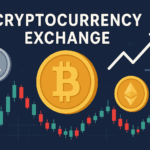In today’s fast-paced digital world, the financial landscape is constantly evolving, with new technologies and innovations reshaping the way we transact and invest. CeDeFi: Revolutionizing the Financial Landscape of Tomorrow. Among these groundbreaking changes is the rise of CeDeFi, a powerful fusion of decentralized finance (DeFi) and traditional centralized finance (CeFi). CeDeFi, short for Centralized Decentralized Finance, is revolutionizing the way we interact with money, offering the best of both worlds. By combining the security and reliability of centralized systems with the transparency and accessibility of decentralized platforms, CeDeFi is unlocking a world of possibilities for individuals and businesses alike.
In this article, we will explore the key features and benefits of CeDeFi, as well as its potential to transform the financial landscape of tomorrow. Join us as we delve into this exciting revolution and discover how CeDeFi is paving the way for a more inclusive, efficient, and decentralized financial future.
What is CeDeFi and how does it work?
CeDeFi stands at the intersection of centralized finance and decentralized finance, harnessing the strengths of both to create a truly innovative financial ecosystem. In traditional finance, centralized systems such as banks and financial institutions act as intermediaries, holding custody of assets and facilitating transactions. On the other hand, decentralized finance leverages blockchain technology to eliminate intermediaries and enable peer-to-peer transactions.
CeDeFi takes the best aspects of both approaches and combines them into a cohesive system. It utilizes centralized infrastructure to ensure security, scalability, and regulatory compliance, while leveraging the transparency and accessibility of decentralized platforms. In CeDeFi, users can benefit from the security and convenience of centralized systems, such as asset custody and customer support, while also enjoying the transparency and financial sovereignty provided by decentralized platforms.
By integrating smart contracts and blockchain technology, CeDeFi enables trustless transactions, automated processes, and programmable financial instruments. This allows for the creation of decentralized applications (DApps) and smart contracts that can execute financial agreements without the need for intermediaries. In essence, CeDeFi empowers individuals and businesses to take control of their finances while maintaining a level of trust and security provided by centralized systems.
Key advantages of CeDeFi
CeDeFi offers several key advantages that make it a compelling option for both individuals and businesses. Firstly, CeDeFi provides enhanced financial inclusivity by removing barriers to entry. Traditional financial systems often exclude individuals without access to banking services or those who reside in underserved regions. CeDeFi, with its decentralized nature, allows anyone with an internet connection to participate in financial activities, access loans, and invest in various assets.
Moreover, CeDeFi offers increased transparency and auditability. Traditional financial systems can be opaque, making it difficult for individuals to understand how their funds are being managed. With CeDeFi, all transactions are recorded on the blockchain, providing a transparent and immutable ledger that can be audited by anyone. This ensures that funds are being used as intended and reduces the risk of fraud.
Another advantage of CeDeFi is its potential for cost reduction. Traditional financial systems often involve numerous intermediaries, each charging fees for their services. By eliminating intermediaries and automating processes through smart contracts, CeDeFi significantly reduces transaction costs. This opens up opportunities for individuals and businesses to access financial services at a fraction of the cost compared to traditional systems.
The potential impact of CeDeFi on traditional finance
CeDeFi has the potential to disrupt and transform the traditional financial landscape in various ways. One of the most significant impacts of CeDeFi is its ability to provide financial services to the unbanked and underbanked populations. According to the World Bank, approximately 1.7 billion adults worldwide remain unbanked, lacking access to basic financial services. CeDeFi can bridge this gap by offering financial services through decentralized platforms, allowing individuals to store value, make payments, and access loans without relying on traditional banks.
Furthermore, CeDeFi can enhance financial stability by reducing the risk of systemic failures. In traditional finance, the failure of a single institution can have far-reaching consequences, as seen during the 2008 global financial crisis. CeDeFi’s decentralized nature mitigates this risk by distributing financial activities across a network of participants, reducing the concentration of power and control. This decentralization ensures that no single point of failure can bring down the entire system, enhancing the overall resilience of the financial ecosystem.
CeDeFi also has the potential to democratize investment opportunities. In traditional finance, high barriers to entry often limit investment opportunities to institutional investors and high-net-worth individuals. CeDeFi, however, allows for fractional ownership and peer-to-peer lending, enabling individuals to invest in a diverse range of assets, such as real estate, stocks, and even digital assets like cryptocurrencies. This opens up new avenues for wealth creation and investment diversification for individuals of all backgrounds.
Challenges and risks of CeDeFi
While CeDeFi offers numerous advantages, it also presents certain challenges and risks that need to be addressed. One of the main challenges lies in regulatory compliance. As CeDeFi operates at the intersection of centralized and decentralized systems, it must navigate the complex regulatory landscape governing both. Regulators are still catching up with the rapid pace of innovation in the blockchain and cryptocurrency space, which can create uncertainty for CeDeFi projects and platforms. Clear and comprehensive regulatory frameworks are necessary to ensure the long-term viability and adoption of CeDeFi.
Another challenge is the potential for smart contract vulnerabilities and security breaches. CeDeFi relies heavily on smart contracts to automate financial processes and execute agreements. However, smart contracts are not immune to bugs or vulnerabilities, which can be exploited by malicious actors. This highlights the importance of thorough security audits and ongoing monitoring to identify and patch any vulnerabilities before they can be exploited.
Additionally, CeDeFi faces scalability limitations due to the inherent constraints of blockchain technology. While decentralized platforms offer transparency and security, they often struggle with scalability and transaction throughput. As more users flock to CeDeFi platforms, there is a need for innovative solutions to improve scalability and ensure smooth user experiences without compromising security.
CeDeFi use cases and examples
CeDeFi has already found applications in various sectors, showcasing its potential to revolutionize traditional finance. One prominent use case is decentralized lending and borrowing platforms. CeDeFi allows individuals to lend their assets directly to borrowers without the need for intermediaries, enabling more efficient and cost-effective lending processes. CeDeFi: Revolutionizing the Financial Landscape of Tomorrow. Platforms like Aave and Compound are leading the way in this space, providing users with the opportunity to earn interest on their digital assets or borrow against them.
Another compelling use case is decentralized exchanges (DEXs). CeDeFi DEXs enable users to trade digital assets directly with one another, eliminating the need for a central exchange to facilitate transactions. Uniswap, a decentralized exchange built on the Ethereum blockchain, has gained significant popularity by providing users with a seamless and decentralized trading experience.
CeDeFi has also made strides in the insurance industry. Decentralized insurance platforms leverage CeDeFi principles to offer more transparent and accessible insurance products. By eliminating intermediaries and automating claims processes through smart contracts, CeDeFi insurance platforms can provide faster claim settlements and reduce costs. Projects like Nexus Mutual and Cover Protocol are at the forefront of this CeDeFi application, offering users the opportunity to participate in a decentralized insurance marketplace.
How to get started with CeDeFi
Getting started with CeDeFi requires a few key steps to navigate the decentralized financial landscape. Firstly, individuals need to familiarize themselves with the basics of blockchain technology and cryptocurrencies. Understanding concepts such as wallets, private keys, and smart contracts is crucial for engaging with CeDeFi platforms securely.
Next, individuals can explore CeDeFi platforms and projects that align with their financial goals and interests. Researching and comparing different platforms will help users identify trustworthy and reputable projects. It is important to evaluate factors such as security measures, user experience, and community engagement before committing funds to any CeDeFi project.
Once a suitable platform is selected, individuals can create a wallet and securely store their digital assets. Wallets can be either hardware devices or software applications that allow users to manage their cryptocurrencies and interact with CeDeFi platforms. It is crucial to follow best practices for wallet security, including using strong passwords, enabling two-factor authentication, and keeping backups of wallet recovery phrases.
Finally, individuals can start exploring the various CeDeFi services offered by platforms, such as lending, borrowing, staking, or trading. It is important to start with small amounts and gradually increase exposure as familiarity and confidence grow. CeDeFi: Revolutionizing the Financial Landscape of Tomorrow. Keeping up with the latest developments, news, and security practices in the CeDeFi space is also essential for a successful and secure experience.
Top CeDeFi projects and platforms
The CeDeFi landscape is rapidly evolving, with numerous projects and platforms vying for dominance. While it is challenging to pinpoint the definitive “top” projects, several notable names have emerged as leaders in the CeDeFi space.
One such project is MakerDAO, which pioneered the concept of decentralized stablecoins. MakerDAO’s DAI stablecoin is backed by collateralized debt positions (CDPs) and is designed to maintain a stable value relative to the US dollar. Users can create DAI by locking up their digital assets as collateral, providing stability in an otherwise volatile cryptocurrency market.
Another prominent CeDeFi platform is Compound, which operates as a decentralized lending and borrowing protocol. Users can deposit their digital assets into Compound and earn interest or borrow against their collateral. The interest rates are determined algorithmically based on supply and demand, creating a dynamic lending market.
Uniswap, mentioned earlier as a decentralized exchange, has gained significant traction and popularity due to its user-friendly interface and the ability to trade a wide range of tokens directly from users’ wallets. Uniswap operates on an automated market maker (AMM) model, allowing users to provide liquidity to different token pairs and earn trading fees.
Future prospects and trends in the CeDeFi space
The future of CeDeFi holds tremendous potential for continued growth and innovation. CeDeFi: Revolutionizing the Financial Landscape of Tomorrow. As the technology matures and regulatory frameworks become more defined, CeDeFi is likely to witness increased adoption and integration into mainstream finance. We can expect to see more traditional financial institutions exploring CeDeFi solutions and partnering with established players in the space.
Scalability solutions, such as layer 2 protocols and interoperability between different blockchain networks, will be crucial for CeDeFi to reach mass adoption. These solutions aim to address the scalability limitations of existing blockchain networks, enabling faster and more cost-effective transactions.
Moreover, the intersection of CeDeFi and other emerging technologies, such as artificial intelligence and Internet of Things, presents exciting opportunities for further innovation. CeDeFi can leverage AI algorithms for risk assessment, automated lending, and personalized financial services. Integration with IoT devices can enable seamless and secure financial transactions in a connected world.
In conclusion, CeDeFi is revolutionizing the financial landscape by combining the best aspects of centralized and decentralized finance. It offers enhanced inclusivity, transparency, and cost efficiency compared to traditional financial systems. While CeDeFi presents challenges and risks, its potential to transform traditional finance, provide financial services to the unbanked, and democratize investment opportunities is undeniable. As individuals and businesses embrace the CeDeFi revolution, a more inclusive, efficient, and decentralized financial future awaits.






















0 Comments